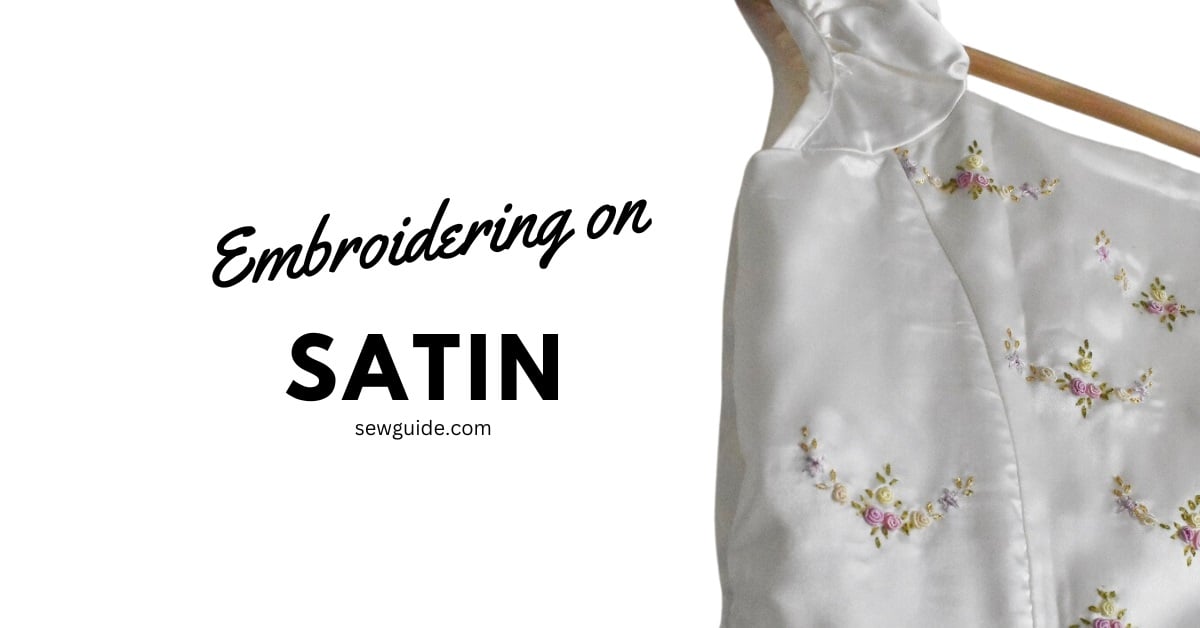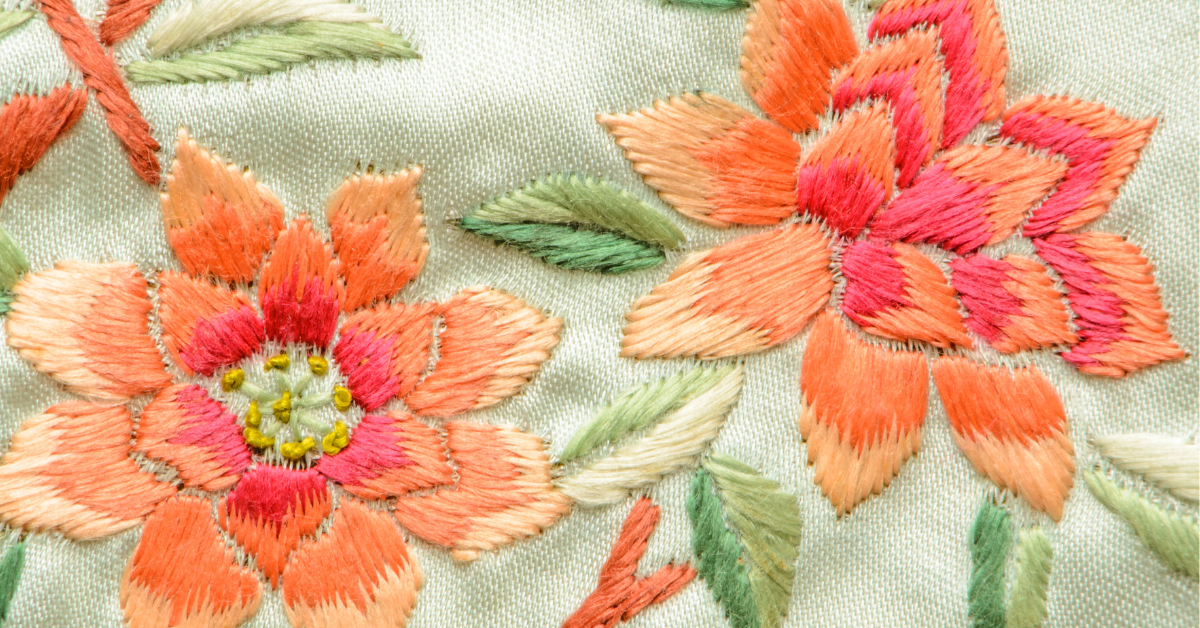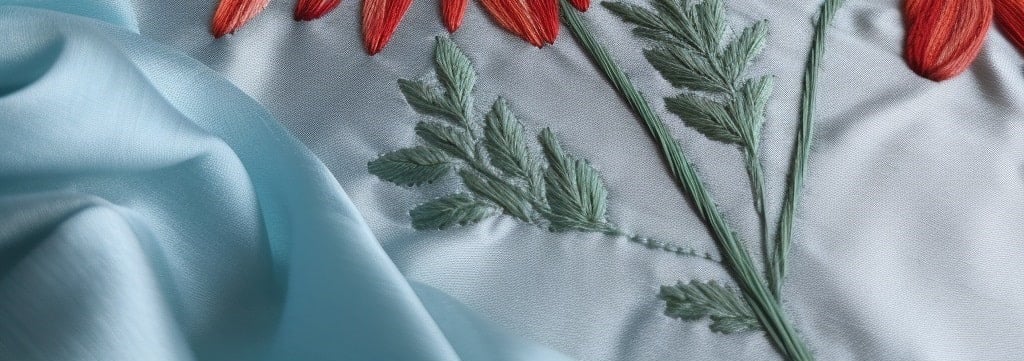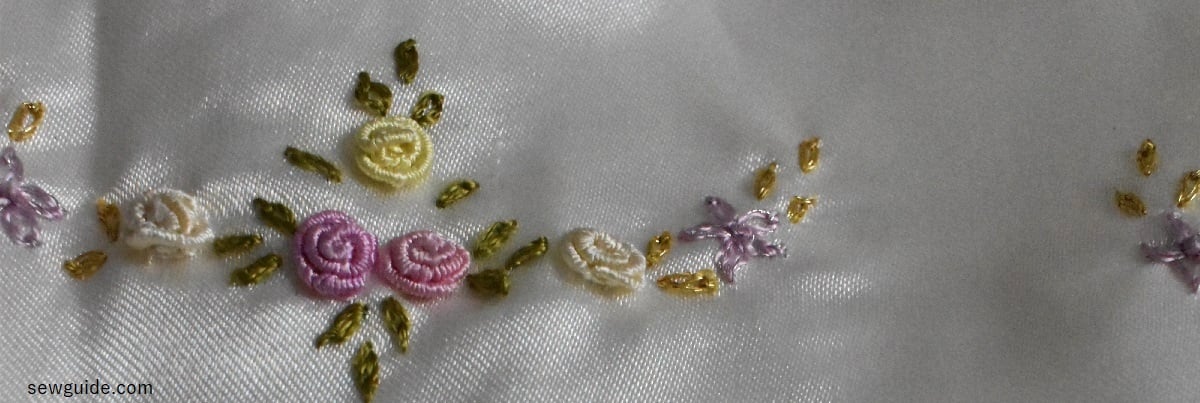If Satin does not look so good on clothes, I will not embroider on it. To be frank, it is a hassle, unless you are very careful.
Satin is one of the most elegant fabrics. It has a subtle shine, soft texture, and good drape. Everything needed for a good dressmaking fabric. I am talking about the expensive, good looking, dressmaking satin. The smooth texture and glossy sheen of Satin make it ideal for kids’ party dresses and elegant blouses. And embroidered Satin is beyond beautiful.
So what is the hassle?

Problems when embroidering on Satin
- Problems when embroidering on Satin
- It is so smooth that it can get snags.
- It is too thin that it has little stability on its own.
- It is so soft that it is slippery
- It is so thin that it can be easily distorted
- It is so lightweight that it wrinkles.
- It is so shiny that everything shows
- Do you have to Prewash satin?
- What is the difference between different types of satin fabrics?
- Best Hand stitches for embroidering on Satin
- Transferring patterns on to Satin
- Start embroidering on Satin.
- Caring for Embroidered Satin
It is so smooth that it can get snags.
So smooth that even your hands can damage it. I mean, if you have rough hands with callouses, you may want to soften them before you start your embroidery. Wet and moisturize them for a week before starting any intricate embroidery. This will keep your hands from snagging the satin fabric.
Satin is made of satin weave; in satin weave, the fibers used in the fabric float on the surface more than in other weaving patterns. These floating fibers results in the smooth and shiny surface of Satin. It also makes Satin more susceptible to snagging, as the floating fibers are more prone to catching on objects or rough surfaces.
Satin usually has a pebbly-crepe backside. It prevents the fabric from slipping and sliding. But the front side is enough to give me nightmares.
And keep your nails short.
Trim your nails to a shorter length to minimize the risk of them catching on the Satin while you’re embroidering.
Otherwise also, You have to handle the fabric with care.
Avoid excessive rubbing or tugging. Use a gentle touch while stitching to minimize the chances of snags.

It is too thin that it has little stability on its own.
So you have to use a Stabilizer.
Use a stabilizer underneath the satin fabric. Stabilizers provide additional support. Use thin interfacing, or use silk organza fabric.
If you use iron on stabilizer, it can distort the hand of the material. You can use a tear-away stabilizer that can be easily removed without leaving behind residue or fibers on the fabric. The tear-away stabilizer can be taken out after the work is done.
Attach the stabilizer to the back of the fabric with a temporary spray adhesive.
Keep the satin fabric wrong side up in front of you and use a temporary spray adhesive to attach it to the fabric. Spray the stabilizer with a Temporary Spray Adhesive, evenly.
Place the sprayed side of the stabilizer onto the wrong side of the fabric. Use your hand to attach them together.
This will give you a smooth and stable surface for embroidery.
It is so soft that it is slippery
So you have to use an Embroidery Hoop or Frame.
Using an embroidery hoop or frame will keep the Satin taut and prevent it from shifting too much and minimize slipping.
It is so thin that it can be easily distorted
Make sure not to stretch the fabric too much on the embroidery hoop, as that can distort the weave.
Maintaining the same thread tension is very important for avoiding distorting the fabric.
It is so lightweight that it wrinkles.
So press the Satin with a low setting on your iron (but enough to remove the wrinkles) – Satin is one of the most susceptible fabrics to iron scorching. But any fabric should be smooth before embroidering, and you have to press the wrinkly Satin, period.
It is so shiny that everything shows
Other than the wrinkles, every speck of dirt on your hands, surface, machine, even large needle holes and inconsistencies in embroidery stitches – all will be visible on the shiny surface. So keep everything clean and neat. No margin of error with this fabric.

Do you have to Prewash satin?
It is better to prewash the material to remove any extra finish on it and also to finish the shrinking that is inherent in fabrics. Hand wash your Satin. You risk losing the luster of the fabric if you toss it into a washing machine. Wash the Satin with baby shampoo in cool water. Soak the material for a few minutes. Remove from the water and rinse well. Now roll in a towel to remove excess moisture. Lay flat to dry.
What is the difference between different types of satin fabrics?
Synthetic Satin does not have the same natural luster as silk. But silk satin is not readily available and is also very costly when available. Synthetic Satin may be made of polyester, acetate, or nylon, so all the precautions you would use for these materials should be taken.
Best Hand stitches for embroidering on Satin
French knot flowers look the best on kids’s satin frocks. These flowers are easy to make, as the less work the better if you are not experienced.

Do make some effort to hide knots and thread tails for a clean finish. You can use all other hand embroidery stitches, except the counted stitch embroidery. As the weave of the material is not visible on the outside, if you want to do counted thread work like cross stitch, you will have to use the dissolving canvas method – ie keep the dissolving canvas on top, mark the design, do the embroidery and then remove the thread one by one. You can buy this material as water-soluble Aida fabric.
Beads and sequins also look very good on Satin. The luxurious look of Satin can be enhanced with these decorations.
Transferring patterns on to Satin
Tracing (using tracing paper) and iron-on transfers (heat-activated).
Start embroidering on Satin.
Start embroidering from the center of your design and work outward. Use gentle and even pressure while stitching. Avoid pulling or tugging on the fabric.
For sewing the Satin after you have embroidered, use a sharp thin (70/10) needle on your sewing machine. And use couture finishes for the best looks. For eg, french seams to conceal the seam edges, or seam binding etc.
Caring for Embroidered Satin
After the embroidery is done, delicate hand washing is recommended. And avoid wringing or twisting. Also, dry flat.
Related posts: Types of Satin fabrics; Sewing with satin fabric.
